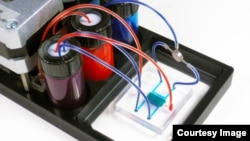Testing new drugs for safety and effectiveness is an expensive and time-consuming process. Designing silicon computer chips that mimic human organs, can make that process faster and cheaper.
The silicon chips, smaller than a child's hand, are lined with living cells that function and respond like specific organs. The chips are being created as part of the Tissue Chip for Drug Screening Program to evaluate the safety of drug compounds.
The program is led by the National Center for Advancing Translational Sciences (NCATS)
NCATS Associate Director Danilo Tagle describes how a 3-D chip created to replicate a lung works.
“In that case, it would be cells representing the air sacs, that would be represented on this bioengineered devices and allowing it to breathe and expand, and be able to take in air [and] take in fluids just like a normal lung would," he said. "In the case of a heart, it would be representing the heart muscles and be able to show contractibility and regular beating of the heart muscles."
Chips containing tiny replicas of the digestive system mimic the real functions of the human stomach and intestine, moving when digesting food.
Drugs are introduced into the tiny organs for testing through micro-tubes. Experiments with the tissue chips have produced more accurate data than conventional tests using animal or cell models.
NCATS just issued $17 million in grants to develop, over the next three years, an entire human organ system.
“So that it becomes integrated, linked together and functioning, almost like a human body on a chip," said Tagle.
With an interconnected system, researchers say they can safely evaluate the impact of a drug on different organ systems, for example checking for liver toxicity, while observing its effect on the organ it's designed to target.
New medications may pass initial safety tests in lab animals, Tagle says.
“But once they are tried in humans, they actually develop toxic side effects," he said.
Scientists want to streamline the drug development process; they hope the tissue chips will help them identify the safest and most promising drugs before they go into human clinical trials.
